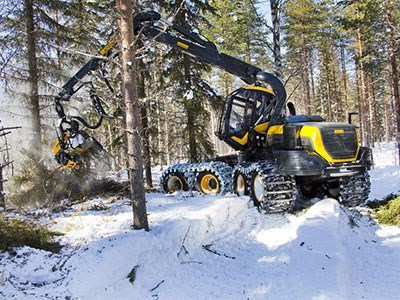The tenacity to stay the course and get their fair share of the economic benefits from natural resources has allowed a group of First Nations to gain ground in the Kenogami Forest.
Recently, the fledgling Ginoogam Development Corporation was allocated 200,000 cubic metres of softwood lumber this year and 250,000 cubic metres next year on the northwestern Ontario Crown forest management unit, which falls within the traditional territories of Aroland, Long Lake #58 and Ginoogaming.
For John O'Nabigon, the corporation’s president, having control of such a sizeable wood supply allows them to leverage opportunities to participate with industry on an equal footing.
“We felt it was in our rights, not only as citizens but within our Aboriginal rights, to share in the economic benefits with the resource we have. We’ve never given up pursuing that.”
There is a provincial wood directive to send the Kenogami fibre to the AV Terrace Bay pulp mill, but they’ve negotiated with government and industry to set aside a portion of that allocation for training members from the communities.
The year-old development corporation is an equal partnership between the three communities who’ve subscribed to the concept of equitable economic participation in the Kenogami Forest.
“It was our choice as three First Nations to pursue this corporation and an overlapping licence as one way to get started,” said O’Nabigon, who is also a Long Lake #58 councillor.
The forest license holder is Needak Inc., a corporation of seven area First Nations.
At 4.9 million acres, Kenogami is the second largest area of forest resources in Ontario, and includes the towns of Nakina, Geraldton, Longlac, Schreiber and Terrace Bay.
The corporation is looked upon as a job creation and training vehicle for the communities, allowing them to build capacity and take advantage of opportunities long withheld from them by the Crown and industry.
“There’s always been a big pie in the Kenogami and it’s been divided up and we never had a piece,” said O’Nabigon.
Faced with high unemployment, participation by members in forestry has always been limited to a handful of people working in the sector. And O’Nabigon said harvesting contractors weren’t always keen on training Indigenous people.
“It costs money to train and production levels go down. The forestry industry is a pretty tight (cost-control) business.”
In the past, each community had been allocated 20,000 cubic metres a year to harvest, but it was never enough to run anything commercially worthwhile.
“We’ve always been handed crumbs where we couldn’t do any feasible operations with what we had. We were told straight that we would not be able to handle more, or have the capacity or training to do it,” said O’Nabigon.
But that attitude from the “old guard” has changed from the top Crown bureaucrats on down.
Changes in Ontario’s forest tenure system have empowered First Nations to have more of a say and greater participation.
One of the province’s stated goals is to shift away from single entity sustainable forest licence (SFL) holders – like a wood-using mill – to Enhanced SFL (E-SFL) holders with multiple stakeholders.
This new model means mandatory and meaningful involvement with local and Aboriginal communities, creating greater separation between mills and forest management, discouraging the hoarding of timber, and introducing new entrants to the sector.
Their licence on the Kenogami is classified as an enhanced Forest Resource Licence, but talks are underway with the government to convert it to an E-SFL.
“There is a need for the First Nations to starting talking about the E-SFL. I think industry wants to talk about it and the Crown also,” said O’Nabigon.
Still in the embryo stage, stakeholders of the development corporation hope to have a general manager in place by April 1.
That person will be responsible for negotiating allocations and sales contracts with mills, supervising harvesting and replanting activities, and identifying business opportunities.
Eventually, revenue from timber sales will go toward staffing and supporting the corporation.
Assisting them is consultant Byron LeClair, the former CEO of Pic River Energy and Forestry, who helped established renewable energy projects in that First Nation community and a harvesting company before departing after a 27-year career.
“He has a lot of forestry background and is helping us put our business together. He’s got a clear understanding of all the regulations. He’s helping with the business side and dealing with presenting our options to the Crown and local industry,” said O’Nabigon.
He said they’re not yet in a position to be drawing up lists to procure harvesting equipment.
“We want to establish ourselves on the harvesting side, get some experience and generate dollars to reinvest into other ideas.
Harvesting will be the main driver in the beginning, but down the road O’Nabigon said there will be road building and maintenance, silviculture work, and studying value-added opportunities in utilizing unused hardwood species and wood pellet production.
“Once we have our foot in, we can explore a lot of ideas.
“Potentially, we may have some entrepreneurs among our members where they can become truck drivers, owner-operators, and some things on the machinery side,” said O’Nabigon. “Hopefully we can get some training happening.”
With some timber allocation set aside, O’Nabigon said the corporation would like to use it to train members without facing intense production and deadline pressures while still allowing fibre supply to move to those that need it.
The corporation also has an agreement to develop a business relationship with Long Lac Wood Industries.




